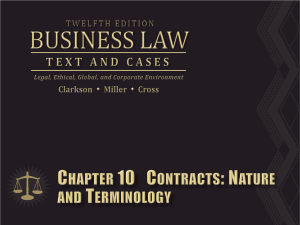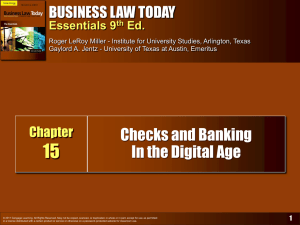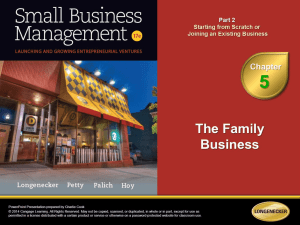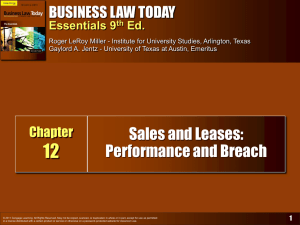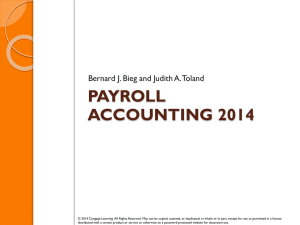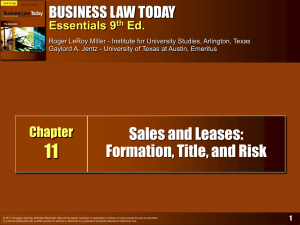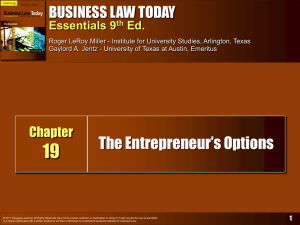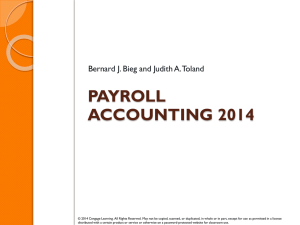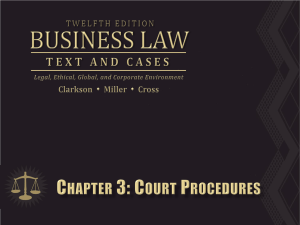Business Law Today, Essentials, 9th Ed.
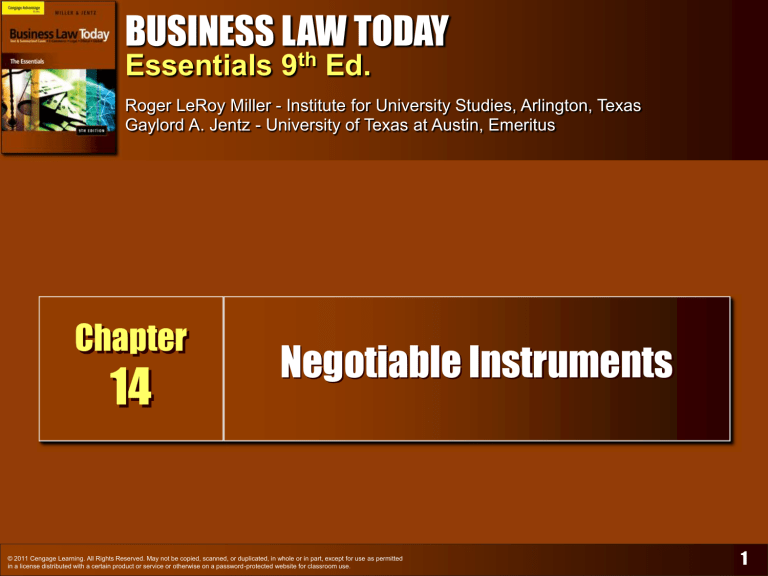
BUSINESS LAW TODAY
Essentials 9 th Ed.
Roger LeRoy Miller - Institute for University Studies, Arlington, Texas
Gaylord A. Jentz - University of Texas at Austin, Emeritus
Chapter
14
Negotiable Instruments
© 2011 Cengage Learning. All Rights Reserved. May not be copied, scanned, or duplicated, in whole or in part, except for use as permitted in a license distributed with a certain product or service or otherwise on a password-protected website for classroom use.
1
Learning Objectives
What requirements must an instrument meet to be negotiable?
What are the requirements for attaining the status of a holder in due course (HDC)?
What is the difference between signature liability and warranty liability?
Certain defenses are valid against all holders, including HDCs. What are these defenses called?
Name four defenses that fall within this category.
Certain defenses can be used against an ordinary holder but are not effective against an
HDC. What are these defenses called? Name four defenses that fall within this category.
2
© 2011 Cengage Learning. All Rights Reserved. May not be copied, scanned, or duplicated, in whole or in part, except for use as permitted in a license distributed with a certain product or service or otherwise on a password-protected website for classroom use.
Articles 3 and 4 of the UCC
A “negotiable instrument” is a signed writing containing an unconditional promise to pay an exact sum of money.
2002 Revisions updated UCC with regard to e-commerce and UETA.
The term “Record” now replaces “Writing.”
Other updates related to telephone transactions.
© 2011 Cengage Learning. All Rights Reserved. May not be copied, scanned, or duplicated, in whole or in part, except for use as permitted in a license distributed with a certain product or service or otherwise on a password-protected website for classroom use.
3
Types of Instruments
© 2011 Cengage Learning. All Rights Reserved. May not be copied, scanned, or duplicated, in whole or in part, except for use as permitted in a license distributed with a certain product or service or otherwise on a password-protected website for classroom use.
4
Drafts and Checks
Draft is Unconditional Order to Pay involving Three Parties:
Drawer (Customer), Drawee (Bank) and
Payee.
© 2011 Cengage Learning. All Rights Reserved. May not be copied, scanned, or duplicated, in whole or in part, except for use as permitted in a license distributed with a certain product or service or otherwise on a password-protected website for classroom use.
5
Drafts and Checks
Time Drafts and Sight Drafts.
Time: payable at a future time.
Sight: payable on sight (on demand).
© 2011 Cengage Learning. All Rights Reserved. May not be copied, scanned, or duplicated, in whole or in part, except for use as permitted in a license distributed with a certain product or service or otherwise on a password-protected website for classroom use.
6
Drafts and Checks
Trade acceptances: Seller is drawer and
Payee.
Checks (cashier’s, teller’s and traveler’s) are drafts on a bank.
© 2011 Cengage Learning. All Rights Reserved. May not be copied, scanned, or duplicated, in whole or in part, except for use as permitted in a license distributed with a certain product or service or otherwise on a password-protected website for classroom use.
7
Promissory Note
© 2011 Cengage Learning. All Rights Reserved. May not be copied, scanned, or duplicated, in whole or in part, except for use as permitted in a license distributed with a certain product or service or otherwise on a password-protected website for classroom use.
8
Promissory Notes and CD’s
Promissory Notes are PROMISES to pay.
Two party instruments:
Maker (Promisor) and
Bearer (Promisee).
Certificates of Deposit (CDs): two party instruments.
© 2011 Cengage Learning. All Rights Reserved. May not be copied, scanned, or duplicated, in whole or in part, except for use as permitted in a license distributed with a certain product or service or otherwise on a password-protected website for classroom use.
9
Small CD
© 2011 Cengage Learning. All Rights Reserved. May not be copied, scanned, or duplicated, in whole or in part, except for use as permitted in a license distributed with a certain product or service or otherwise on a password-protected website for classroom use.
10
Requirements for Negotiability
(1) Writing signed by the maker or the drawer.
(2) Unconditional promise or order to pay
(3) A fixed amount of money.
(4) Payable on demand or at a definite time.
(5) Payable to Order or Bearer.
11
© 2011 Cengage Learning. All Rights Reserved. May not be copied, scanned, or duplicated, in whole or in part, except for use as permitted in a license distributed with a certain product or service or otherwise on a password-protected website for classroom use.
Requirements for Negotiability
Written Form.
Must be on material that lends itself to permanence.
Writing must have portability.
Signatures.
Signed by maker (if note or CD)
Signed by drawer (if check or draft).
Any symbol (or electronic) is good.
© 2011 Cengage Learning. All Rights Reserved. May not be copied, scanned, or duplicated, in whole or in part, except for use as permitted in a license distributed with a certain product or service or otherwise on a password-protected website for classroom use.
12
Requirements for Negotiability
Unconditional Promise or Order to
Pay.
Payment cannot be conditioned on the occurrence or nonoccurence of any event.
Only unconditional promises are negotiable.
Express promise to pay.
Fixed Amount of Money.
Ascertainable on face of instrument.
© 2011 Cengage Learning. All Rights Reserved. May not be copied, scanned, or duplicated, in whole or in part, except for use as permitted in a license distributed with a certain product or service or otherwise on a password-protected website for classroom use.
13
Requirements for Negotiability
Payable on Demand or Definite Time.
Includes words “payable at sight” or
“payable upon presentment.”
If no time presented, it is presumed payable on demand.
Definite Time.
To be negotiable, instrument must be payable on demand or at a definite time.
14
© 2011 Cengage Learning. All Rights Reserved. May not be copied, scanned, or duplicated, in whole or in part, except for use as permitted in a license distributed with a certain product or service or otherwise on a password-protected website for classroom use.
Requirements for Negotiability
Acceleration Clause.
Allows holder to demand payment if certain condition occurs.
Negotiable because exact value can be determined and payable on a specific date.
CASE 14.1
Foundation Property Investments,
LLC v. CTP, LLC (2007). Accepting repeated late payments waives the right to demand full payment under an acceleration clause.
Extension Clause.
Reverse of an acceleration clause, extends maturity date to be extended forward into time.
© 2011 Cengage Learning. All Rights Reserved. May not be copied, scanned, or duplicated, in whole or in part, except for use as permitted in a license distributed with a certain product or service or otherwise on a password-protected website for classroom use.
15
Requirements for Negotiability
Payable to Order or Bearer.
Order instrument is payable to identified person or order. Identified person may transfer check to whomever she wishes.
Bearer instrument is literally payable to the possessor of the instrument.
© 2011 Cengage Learning. All Rights Reserved. May not be copied, scanned, or duplicated, in whole or in part, except for use as permitted in a license distributed with a certain product or service or otherwise on a password-protected website for classroom use.
16
Factors That Do Not Affect Negotiability
Undated checks.
Pre or Post-Dating Checks.
Handwritten Terms.
Outweigh typed or printed terms.
Words outweigh Figures.
“With Interest.”
Check says “Nonnegotiable.”
17
© 2011 Cengage Learning. All Rights Reserved. May not be copied, scanned, or duplicated, in whole or in part, except for use as permitted in a license distributed with a certain product or service or otherwise on a password-protected website for classroom use.
Transfer of Instruments
Transfer by Assignment.
Transferee is an Assignee.
Transfer by Negotiation.
Transfer in which the transferee becomes a holder.
• Negotiating Order Instruments.
• Negotiating Bearer Instruments.
© 2011 Cengage Learning. All Rights Reserved. May not be copied, scanned, or duplicated, in whole or in part, except for use as permitted in a license distributed with a certain product or service or otherwise on a password-protected website for classroom use.
18
Indorsements
Indorsement is a signature, with or without words or statements.
Indorser: person who transfers instrument by signing it and delivering to another person.
19
© 2011 Cengage Learning. All Rights Reserved. May not be copied, scanned, or duplicated, in whole or in part, except for use as permitted in a license distributed with a certain product or service or otherwise on a password-protected website for classroom use.
Indorsements
Blank
Indorsements.
Special
Indorsements.
Qualified
Indorsements.
© 2011 Cengage Learning. All Rights Reserved. May not be copied, scanned, or duplicated, in whole or in part, except for use as permitted in a license distributed with a certain product or service or otherwise on a password-protected website for classroom use.
20
Restrictive Indorsements
Conditional Indorsements.
Indorsements for Deposit and
Collection.
© 2011 Cengage Learning. All Rights Reserved. May not be copied, scanned, or duplicated, in whole or in part, except for use as permitted in a license distributed with a certain product or service or otherwise on a password-protected website for classroom use.
21
Restrictive Indorsements
Trust (Agency) Indorsements.
© 2011 Cengage Learning. All Rights Reserved. May not be copied, scanned, or duplicated, in whole or in part, except for use as permitted in a license distributed with a certain product or service or otherwise on a password-protected website for classroom use.
22
Miscellaneous Indorsement Problems
Misspelled Names. Indorsement should be identical to the name on the instrument.
Alternative or Joint Payees. Only one of the payees needs to indorse.
Suspension of the Drawer’s Obligation.
23
© 2011 Cengage Learning. All Rights Reserved. May not be copied, scanned, or duplicated, in whole or in part, except for use as permitted in a license distributed with a certain product or service or otherwise on a password-protected website for classroom use.
Holder in Due Course (HDC)
A holder (assignee) is generally subject to the same defenses that the assignor is subject to.
A holder in due course (HDC) takes the instrument FREE of most of the defenses and claims that could be asserted against the transferor.
24
© 2011 Cengage Learning. All Rights Reserved. May not be copied, scanned, or duplicated, in whole or in part, except for use as permitted in a license distributed with a certain product or service or otherwise on a password-protected website for classroom use.
Requirements for HDC Status
A Holder in Due Course must:
Take for Value:
• Performance.
• Payment for preexisting debt.
• Irrevocable commitment.
Taking in Good Faith (honesty in fact).
CASE 14.2
Georg v. Metro Fixtures
Contractors, Inc. (2008). Payee of check that was embezzled was an HDC taking in good faith.
Loss is suffered by Metro.
© 2011 Cengage Learning. All Rights Reserved. May not be copied, scanned, or duplicated, in whole or in part, except for use as permitted in a license distributed with a certain product or service or otherwise on a password-protected website for classroom use.
25
Requirements for HDC Status
A Holder in Due Course must:
Take for Value:
Taking in Good Faith (honesty in fact).
Take Without Notice of any defect:
• Overdue, dishonored, uncured, contains unauthorized signature or alteration, defense or claim, irregular or incomplete.
• CASE 14.3
South Central Bank of Daviess
County v. Lynnville National Bank (2009).
South
Central took the check for value, in good faith, and without notice of a defects.
© 2011 Cengage Learning. All Rights Reserved. May not be copied, scanned, or duplicated, in whole or in part, except for use as permitted in a license distributed with a certain product or service or otherwise on a password-protected website for classroom use.
26
Holder Through an HDC
The “Shelter” Principle: Holder, who does not qualify as an HDC, can acquire the rights and privileges of an HDC.
Depends upon whether holder can ‘trace’ her title back to HDC.
Limitations:
Reacquired instruments.
Fraud or illegality.
© 2011 Cengage Learning. All Rights Reserved. May not be copied, scanned, or duplicated, in whole or in part, except for use as permitted in a license distributed with a certain product or service or otherwise on a password-protected website for classroom use.
27
Signature and Warranty Liability
Every party who signs a negotiable instrument is either primarily or secondarily liable for payment.
Primary Liability (only makers and acceptors are primarily liable).
Secondary Liability (contingent liability):
• Proper and Timely Presentment.
• Dishonor.
• Proper Notice.
28
© 2011 Cengage Learning. All Rights Reserved. May not be copied, scanned, or duplicated, in whole or in part, except for use as permitted in a license distributed with a certain product or service or otherwise on a password-protected website for classroom use.
Signature Liability
Accommodation Parties.
Signs for the purpose of lending her name as credit for another party.
Authorized Agents’ Signatures.
If authorized, can bind the principal.
If unauthorized (forgery) signature is void.
© 2011 Cengage Learning. All Rights Reserved. May not be copied, scanned, or duplicated, in whole or in part, except for use as permitted in a license distributed with a certain product or service or otherwise on a password-protected website for classroom use.
29
Special Rules for
Unauthorized Indorsements
Unauthorized Indorsements.
Burden of loss falls on first party to take the instrument with the forged/unauthorized instrument.
Imposter Rule.
Fictitious Payee Rule.
© 2011 Cengage Learning. All Rights Reserved. May not be copied, scanned, or duplicated, in whole or in part, except for use as permitted in a license distributed with a certain product or service or otherwise on a password-protected website for classroom use.
30
Warranty Liability
Transferors make certain implied warranties on instruments they are transferring: Transfer and Presentment.
Transfer Warranties (if consideration):
Transferor has the right to enforce the instrument
All signatures are authentic and authorized
Instrument has not been altered.
Instrument is not subject to a defense or claim.
Transferor has no knowledge of insolvency.
© 2011 Cengage Learning. All Rights Reserved. May not be copied, scanned, or duplicated, in whole or in part, except for use as permitted in a license distributed with a certain product or service or otherwise on a password-protected website for classroom use.
31
Warranty Liability
Presentment Warranties protect the person to whom the instrument is presented:
Person obtaining payment has the right to enforce the instrument.
Instrument has not been altered.
Person accepting has no knowledge that instrument is unauthorized.
© 2011 Cengage Learning. All Rights Reserved. May not be copied, scanned, or duplicated, in whole or in part, except for use as permitted in a license distributed with a certain product or service or otherwise on a password-protected website for classroom use.
32
Defenses, Limitations, and Discharge
Universal (Real) Defenses to Avoid
Liability by ALL Holders, including
HDC’s:
Forgery.
Fraud in the Execution.
Material Alteration.
Discharge in Bankruptcy.
Infancy (Minor).
Illegality.
Mental Incapacity.
Extreme Duress.
© 2011 Cengage Learning. All Rights Reserved. May not be copied, scanned, or duplicated, in whole or in part, except for use as permitted in a license distributed with a certain product or service or otherwise on a password-protected website for classroom use.
33
Personal Defenses
Personal (limited ) Defenses (only holders, not HDC):
Breach of Contract or Warranty.
Lack or Failure of Consideration.
Fraud in the Inducement.
Illegality (voidable).
Mental Incapacity.
Discharge by Payment/Non-Delivery.
© 2011 Cengage Learning. All Rights Reserved. May not be copied, scanned, or duplicated, in whole or in part, except for use as permitted in a license distributed with a certain product or service or otherwise on a password-protected website for classroom use.
34
Federal Limitations on HDC’s
Federal Trade Commission issued rule in
1976 that effectively abolished HDC status in consumer credit transactions.
FTC Rule 433.
Modern application is to car purchases that turn out to be ‘lemons.’
35
© 2011 Cengage Learning. All Rights Reserved. May not be copied, scanned, or duplicated, in whole or in part, except for use as permitted in a license distributed with a certain product or service or otherwise on a password-protected website for classroom use.
Discharge From Liability
All parties are liable when primary party pays the holder the amount in full.
Intentional cancellation discharges the liability of all parties.
Can occur when right of recourse is impaired.
© 2011 Cengage Learning. All Rights Reserved. May not be copied, scanned, or duplicated, in whole or in part, except for use as permitted in a license distributed with a certain product or service or otherwise on a password-protected website for classroom use.
36
